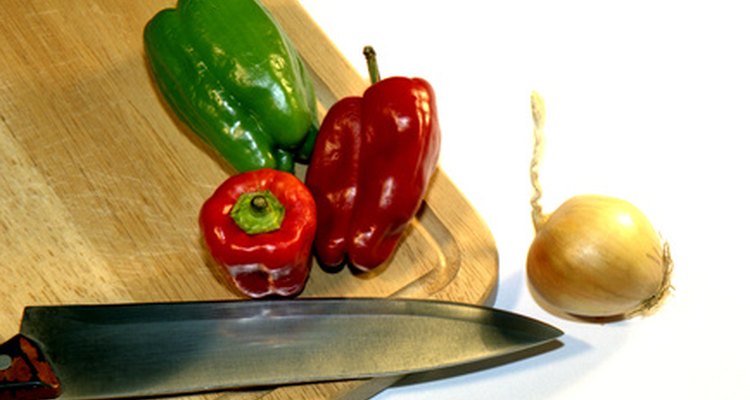
Salsa refers to any number of exotic combinations of chili peppers, tomatoes, corn, nuts, beans or seafood. Equally popular among Hispanics, Americans and Europeans, salsas appear on nearly every continent and never go out of vogue. Tomatillo and tomato salsas, chili salsas, tropical salsas, fruit salsas, corn salsas, bean salsas, garden salsas and herb salsas are some of the most common types, enticing food connoisseurs with their flavors and textures. Salsa peppers have different degrees of hotness. The heat of each is measured by Scoville Heat Units, or SHU.
Mild Peppers
The best mild pepper plants that are suitable for salsa include Bermuda hot peppers and poblano peppers.
Bermuda hot peppers average 6.5 centimeters long and approximately 3 centimeters in diameter. The plant produces white flowers on thick, green foliage and green stems that grow to a maximum height of 60 centimeters. They rank between 500 and 2,000 SHU.
Native Mexican poblano peppers grow to a length of approximately 15 centimeters and a width of 8 centimeters. They are mildly hot and mature to a bright red color when ripe. Poblano peppers are ideal for frying, roasting and stuffing and rank between 500 and 2,500 SHU.
Medium Peppers
Medium pepper plants are slightly hotter than mild pepper plants and are ideal for infusing a little zest in salsa. The best medium pepper plants include jalapeno peppers and rocotillo peppers.
Jalapeno peppers, when ripened, grow to between 5 and 9 centimeters in length. Good quality peppers are green, smooth-skinned and have dry lines indicating hotness. Jalapeno peppers rank between 3,000 and 6,000 SHU.
Bell-shaped rocotillo peppers are yellow or green when unripe and brown, orange or red when ripe. They are typically around 2.5 centimeters wide and 2.5 centimeters long. Rocotillo peppers rank between 1,500 and 2,500 SHU.
Hot Peppers
The best hot peppers for salsa include Serrano peppers, Tabasco peppers and cayenne peppers.
Serrano peppers are biting hot and do not need to be peeled or steamed before using, making them easy to add to salsas. Peppers reach 10 centimeters long, and turn orange, red or brown from a bright green when mature. Serrano peppers are between 10,000 and 20,000 SHUs.
Tabascos, best known for their use in Tabasco sauce, are fiery, tapered peppers that rate between 30,000 to 50,000 on the Scoville scale of heat. Their most unusual feature is that the peppers grow upward, sticking their yellow and red heads out of thick foliage when mature.
Cayenne peppers, also known as Cow Horn Peppers, Guinea spice and bird pepper, is a hot, red-colored chili that is popularly used as flavoring in salsa and for medicinal purposes. The pepper ranks between 30,000 and 50,000 on the Scoville heat scale, and can be used in its powdered form or whole.
Related Articles
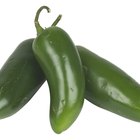
Facts About the Jalapeno Pepper
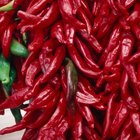
Chinese Hot Pepper Types

Can I Eat the Seeds of a Habanero ...
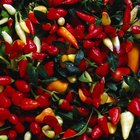
How to Freeze Cherry Peppers

Substitute for Thai Chili
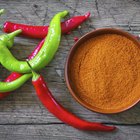
Ancho Chili Powder Vs. Chili Powder

Most Flavorful Hot Peppers

How to Roast & Freeze Habanero and ...

How Much Hotter Is a Habanero Than a ...

How to make Stuffed Jalapeno Peppers ...
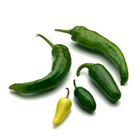
How to Dry Jalapenos

Substitutes for Scotch Bonnet

How to Dry Red Bell Peppers to Make ...

Do Jalapenos Need to Be Refrigerated?

How to Freeze Cayenne Pepper

How to Ripen Red Chili Peppers
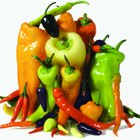
How to Pickle Peppers in Small Batches
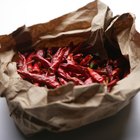
How to Use Dry Red Chili Pods
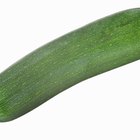
Calories in a Large Zucchini
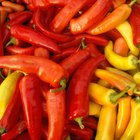
What Peppers Have Capsaicin?
References
- “Chemistry of Spices”; V. A. Parthasarathy, B. Chempakam and T. John Zachariah; 2008 (Pg 274)
- “Peppers of the World”; Dave DeWitt and Paul W. Bosland; 1996 (Pg 17)
- “Superfoods for Dummies”; Brent Agin and Shereen Jegtvig; 2009 (Pg 134)
Writer Bio
Natasha Gilani has been a writer since 2004, with work appearing in various online publications. She is also a member of the Canadian Writers Association. Gilani holds a Master of Business Administration in finance and an honors Bachelor of Science in information technology from the University of Peshawar, Pakistan.
Photo Credits
pepper and knife image by Pavel Bugrov from Fotolia.com